CLEANR Research and Policy Workshops actively advance policy change, address emerging environmental issues and undone science, and support regulatory decision-making. One way in which we achieve these outcomes is via scholarship – peer-reviewed publications, law review articles, and Center reports, briefs, recommendations, and model legislation, rules, and policy guidances.
Faculty and Staff Scholarship
Alejandro Camacho
Book and Book Chapters
- Environmental Protection: Law and Policy, Ninth Edition (with Robert L. Glicksman, William W. Buzbee, Daniel R. Mandelker, and Emily Hammond) (Aspen 2023).
- Teacher’s Manual, Environmental Protection: Law and Policy, Ninth Edition (with Robert L. Glicksman, William W. Buzbee, Daniel R. Mandelker, and Emily Hammond) (Aspen 2023).
- The Endangered Species Act, in Global Climate Change and U.S. Law, Third Edition (Michael B. Gerrard, Jody Freeman & Michael Berger, eds.) (ABA 2023).
- Teacher’s Manual, Property: Cases & Materials, Fifth Edition (with James Charles Smith and Edward J. Larson) (Aspen 2022).
- Property: Cases & Materials, Fifth Edition (with James Charles Smith and Edward J. Larson) (Aspen 2022).
- Reorganizing Government: A Functional and Dimensional Framework(with Robert L. Glicksman) (NYU Press 2019) (reviewed by Joel A. Mintz, 5 Admin. L. Rev. Accord 81-84 (2019); P. Lermack, 57 Choice 695 (2020); Antonio Villalpando Acuña, 29 Gestión y Política Pública 503-509 (2020)).
- Managing ecosystem effects in an era of rapid climate change, in Climate Change Law 555-566 (Elgar, Daniel Farber & Marjan Peeters, Eds. 2016).
- Maintaining Resilience in the Face of Climate Change, in Social-Ecological Resilience and Law 235-264 (Columbia Univ. Press 2014) (with T. Douglas Beard).
- Managing Adaptation: Developing a Learning Infrastructure in the United States’ Federal System, in Implementing Adaptation Strategies by Legal, Economic and Planning Instruments on Climate Change 41-54 (Springer 2014).
Law Journal Articles and Essays
- A Missed Opportunity to Address Ecological Risk from Emerging Biotechnologies: President Biden’s Executive Order on a “Sustainable” Bioeconomy and an Agenda for Future Reforms, 85 Ohio St. L. J. (with David Dana) (forthcoming 2024).
- In the Anthropocene: Adaptive Law, Ecological Health, and Biotechnologies, 15 Law, Innovation & Tech. 280-312, doi: 10.1080/17579961.2023.2184133 (2023).
- Six Priority Recommendations for Improving Conservation under the ESA, 51 Envtl. L. Rep. 10785-10804 (with Melissa L. Kelly & Ya-Wei Li) (2021).
- Designing Regulation Across Organizations: Assessing the Functions and Dimensions of Governance, 15 Reg. & Governance S102-S122 (2021) (with Robert L. Glicksman) (peer reviewed).
- Structured to Fail: Lessons from The Trump Administration’s Faulty Pandemic Planning and Response, 10 Mich. J. Envtl. & Admin. L. 329-81 (2021) (with Robert L. Glicksman).
- De- and Re-constructing Public Governance for Biodiversity Conservation, 73 Vand. L. Rev. 1585-1641 (2020).
- Beyond Preemption, Toward Metropolitan Governance, 39 Stan. Envtl. L.J. 125-198 (2020) (with Nicholas J. Marantz).
- The Trump Card: Tarnishing Planning, Democracy, and the Environment, 50 Envtl. L. Rep. 10281-89 (2020) (with Robert L. Glicksman).
- Bulldozing Infrastructure Planning and the Environment through Trump’s Executive Order 13807, 91 U. Colo. L. Rev. 511 (2020).
- Mitigating Climate Change through Transportation and Land Use Policy, 49 Envtl. L. Rep. 10473-92 (2019) (with Melissa L. Kelly, Nicholas J. Marantz, and Gabriel Weil).
- Improving Water Quality and Ecosystem Health in California’s Marine Managed Areas, 48 Envtl. L. Rep. 10818-36 (2018) (with Elizabeth Taylor and Stephanie Talavera).
- Assessing State Laws and Resources for Endangered Species Protection, 47 Envtl. L. Rep. 10837 (2017) (with Michael Robinson-Dorn, Asena Yildiz, and Tara Teegarden).
- Legal Adaptive Capacity: How Program Goals and Processes Shape Federal Land Adaptation to Climate Change, 87 U. Colo. L. Rev. 711-826 (2016) (with Robert L. Glicksman).
- Emerging Regulatory Experiments in Permit Process Coordination for Endangered Species and Aquatic Resources in California, 46 Envtl. L. Rep. 10131 (2016) (with Elizabeth Taylor, Melissa Kelly, & Stephanie Talavera).
- Lessons from Area-Wide Multi-Agency Habitat Conservation Plans in California, 46 Envtl. L. Rep. 10222 (2016) (with Elizabeth Taylor and Melissa Kelly).
- Going the Way of the Dodo: De-Extinction, Dualisms, and Reframing Conservation, 92 Wash. U. L. Rev. 849-906 (2015) (reprinted in David L. Callies & J.B. Ruhl, eds., Land Use & Env’t L. Rev. 319-378 (Thomson Reuters 2016-2017) (peer reviewed)).
- Functional Government in 3-D, 51 Harv. J. on Legis. 19-88(2014) (with Robert L. Glicksman).
- Community Benefits Agreements: A Symptom, Not the Antidote, of Bilateral Land Use Regulation, 78 Brooklyn L. Rev. 355-383 (2013) (invited).
- Transforming the Means and Ends of Natural Resource Management, 89 N.C. L. Rev. 1405-54 (2011).
- A Learning Collaboratory: Improving Federal Climate Change Adaptation Planning, 2011 BYU L. Rev. 1821-61 (2011).
- Assisted Migration: Redefining Nature and Natural Resource Law under Climate Change, 27 Yale J. on Reg. 171-255 (2010) (reprinted in A. Daniel Tarlock & David L. Callies eds., Land Use & Env’t L. Rev. (Thomson West 2011) (peer reviewed)).
- Collaborative Planning and Adaptive Management in Glen Canyon: A Cautionary Tale, 35 Colum. J. Envtl. L. 1-55 (2010) (with Lawrence Susskind & Todd Schenk).
- Adapting Governance to Climate Change: Managing Uncertainty through a Learning Infrastructure, 59 Emory L. J. 1-77 (2009) (excerpted in Joel A. Mintz, et al., A Practical Introduction to Environmental Law (Carolina Academic Press) (2017).
- Beyond Conjecture: Learning about Ecosystem Management from the Glen Canyon Dam Experiment, 8 Nev. L. J. 942-63 (2008) (invited).
- Can Regulation Evolve? Lessons from a Study in Maladaptive Management, 55 UCLA L. Rev. 293-358 (2007) (reprinted in J. B. Ruhl, Ed., Property Law (Edward Elgar Publishing) (2020)).
- Mustering the Missing Voices: A Collaborative Model for Fostering Equality, Community Involvement and Adaptive Planning in Land Use Decisions, Installment Two, 24 Stan. Envtl. L.J. 269-330 (2005) (reprinted in Patricia Salkin ed., Zoning & Plan. L. Handbook 945-1017 (Thomson West 2006) (peer reviewed)).
- Mustering the Missing Voices: A Collaborative Model for Fostering Equality, Community Involvement and Adaptive Planning in Land Use Decisions, Installment One, 24 Stan. Envtl. L.J. 3-69 (2005) (reprinted in A. Daniel Tarlock & David L Callies eds., Land Use & Env’t L. Rev. 119-181 (Thomson West 2006) (peer reviewed)) (reprinted in Patricia Salkin ed., Zoning & Plan. L. Handbook 863-943 (Thomson West 2006) (peer reviewed)).
Science Articles
- Regulatory Fragmentation: An Unexamined Barrier to Species Conservation Under Climate Change (with Jason S. McLachlan), 3 Frontiers in Climate 735608 (2021), doi: 10.3389/fclim.2021.735608 (reprinted in J.B. Ruhl, et al., eds., Coordinating Climate Change Adaptation as Risk Management 54-61 (2022).
- Governing Complexity: Integrating science, governance, and law to manage accelerating change in the globalized commons (with Barbara Cosens, J.B. Ruhl, Niko Soininen, Lance Gunderson, Brian Chaffin, Robin Craig, Holly Doremus, Robert Glicksman, Rhett Larson, Antti Belinskij, Jukka Simila, Anna-Stiina Heiskanen, and Thorsten Blenckner), 118 Proc. Natl. Acad. Sci. e2102798118 (2021).
- Managed Relocation: Integrating the Scientific, Regulatory, and Ethical Challenges (with Mark Schwartz et al.), 62 BioScience 732-743 (2012).
- A Critical Assessment of Collaborative Adaptive Management in Practice (with Lawrence Susskind and Todd Schenk), 49 J. Applied Ecology 47-51 (2011).
- Reassessing Conservation Goals in a Changing Climate (with Holly Doremus, Jason McLachlan, & Ben Minteer), Issues in Sci. & Tech., Summer 2010, 21-26.
- Multidimensional evaluation of managed relocation (with David Richardson et al.), 106 Proc. Natl. Acad. Sci. 9721-24 (2009).
Reports
- Tap into Resilience: Pathways for Localized Water Infrastructure, CLEANR Briefing Report (with Melissa L. Kelly, Cynthia Koehler, and Caroline Koch) (2021).
- The Six Priority Recommendations for Improving Conservation under the Federal Endangered Species Act, CLEANR Briefing Report (with Melissa L. Kelly & Ya-Wei Li) (2021).
- Climate, Energy, Justice: The Policy Path to a Just Transition for an Energy-Hungry America (2020) (with Shalanda H. Baker, William W. Buzbee, Daniel Farber, Robert L. Fischman, Victor Flatt, Robert L. Glicksman, Alice Kaswan, Alexandra B. Klass, Christine A. Klein, Sarah Krakoff, Joel A. Mintz, Uma Outka, Dave Owen, Daniel J. Rohlf, Karen Sokol, Joseph Tomain, Hannah J. Wiseman, and Sandra B. Zellmer).
- Memo to the Next President: A Progressive Vision of Government and Protective Safeguards, Center For Progressive Reform (Aug. 2016) (with David Driesen, Robert Glicksman, Thomas McGarity, Sidney Shapiro, Joseph Tomain, Robert Verchick, and James Goodwin).
- Making Good Use of Adaptive Management, Center for Progressive Reform White Paper # 1104 (2011) (with Holly Doremus, William L. Andreen, Daniel A. Farber, Robert L. Glicksman, Dale Goble, Bradley C. Karkkainen, Daniel Rohlf, A. Dan Tarlock, Sandra B. Zellmer, Shana Jones, and Yee Huang).
Shorter Legal and Other Publications
- Biden Picks Conservation Advocate Tracy Stone-Manning to Lead the Bureau of Land Management. Here are Five Priorities for Our Public Lands, CPRBlog (April 23, 2021).
- Opinion Analysis: Court favors deliberative-process privilege protections over FOIA transparency goals, SCOTUSblog (Mar. 6, 2021) (with Melissa Kelly).
- Argument analysis: Court considers bright-line and case-specific standards for the Freedom of Information Act’s “deliberative process” privilege, SCOTUSblog (Nov. 4, 2020) (with Melissa L. Kelly).
- Case preview: Court will consider the scope of transparency under the Freedom of Information Act’s key “deliberative process” privilege, SCOTUSblog (Oct. 30, 2020) (with Melissa L. Kelly).
- The Trump Administration’s Latest Unconstitutional Power Grab, Reg. Rev. (Aug. 24, 2020) (with Robert L. Glicksman).
- The Shape of Water After County of Maui v. Hawaii Wildlife Fund, Reg. Rev. (July 28, 2020) (with Melissa Kelly) (highlighted in SCOTUSblog).
- The Trump Administration’s Pandemic Response is Structured to Fail, Reg. Rev. (May 19, 2020)(with Robert L. Glicksman).
- Trump is trying to cripple the environment and democracy, The Hill (Jan. 18, 2020) (with Robert L. Glicksman).
- How to Improve Allocations of Regulatory Authority, Reg. Rev. (Oct. 22, 2019) (with Robert L. Glicksman).
- A Better Approach to Factoring Federalism Considerations into Regulatory Strategies, Notice & Comment (Oct. 14, 2019) (with Robert L. Glicksman).
- Trump’s Decision to Hamstring California’s Climate Authority Is Illogical and Uninformed, The Revelator (Oct. 4, 2019) (with Robert L. Glicksman).
- Trump administration rollbacks disable environmental planning and democracy, The Hill (Sept. 3, 2019).
- What President Trump’s Infrastructure Agenda Gets Wrong, Reg. Rev. (May 6, 2019).
- A defeat on offshore drilling extends the Trump administration’s losing streak in court, The Conversation (April 9, 2019) (with Robert Glicksman), (republished in Chicago Tribune, Houston Chronicle, San Francisco Chronicle, Seattle Post-Intelligencer).
- Acclimatizing Conservation, BLARB (Feb. 4, 2019).
- Blind focus on ‘energy dominance’ may cripple Endangered Species Act, The Hill (Oct. 4, 2018) (with Melissa Kelly).
- Turning power over to states won’t improve protection for endangered species, The Conversation (Jan. 11, 2018) (with Michael Robinson-Dorn) (republished in Los Angeles Times, San Francisco Chronicle, Chicago Tribune, The Associated Press, and other news outlets).
- Wildlife laws aren’t ready for the return of extinct species, AXIOS (June 22, 2017).
- Congress Wants Land Agency to Ignore the Facts and Future, CPRBlog (Feb. 28, 2017) (with Robert Glicksman).
- Legal Adaptive Capacity and How Agencies Respond to Change¸ RegBlog (Aug. 8, 2016).
- On Climate Change Preparation, Record of Land Management Agencies Is Mixed, CPRBlog (July 20, 2016) (with Robert Glicksman).
- Going the Way of the Dodo: De-Extinction, Dualisms, and Reframing Conservation, 46 Envtl. L. Rep. 10701 (2016) (peer reviewed).
- A Visionary but Flawed Program Needs to Evolve, 33 Environmental Forum 50 (May/June 2016).
- Climate Change by Administrative Law?, Daily J. (Feb. 18, 2016) (with Joseph F. C. DiMento).
- Foreword: Environmental Law at UCI, 1 UC Irvine L. Rev. 1081-89 (2012) (with Michael Robinson-Dorn and Joseph DiMento).
- Why Federal Climate Change Legislation Shouldn’t Stop States from Innovating in Adaptation Efforts, CPRBlog (May 27, 2010).
- On Adaptation, Kerry-Lieberman Climate Bill Largely Similar to ACES, But Drops Several Provisions and Provides Less Money, CPRBlog (May 14, 2010).
- Climate Change Adaptation Still Being Given Short Shrift in Local, State, and Federal Government, CPRBlog (November 09, 2009).
- Boxer-Kerry Centralizes Procedures for Adaptation but Lacks Substantive Guidance, CPRBlog (October 07, 2009).
- Interior’s Initiative on Adaptation Will Need to Overcome a Legacy of Inaction, CPRBlog (September 18, 2009).
- Tweaking the Climate Change Adaptation Proposal, CPRBlog (May 05, 2009).
- Waxman-Markey: Adaptation, CPRBlog (April 07, 2009) (with Holly Doremus).
- Climate Change and Regulatory Fragmentation in the Great Lakes Basin, 17 Mich. St. J. Int’l L.139-54(2008).
- Mustering the Missing Voices, Notre Dame Lawyer, Fall 2006, at 24.
- New Source Review Reform: Federal Clean Air Act at a Crossroads, with Robert M. Sussman et al., 23 No. 24 Andrews Hazardous Waste Litig. Rep. 10 (2003).
- CERCLA Rights and Liabilities, with Gene A. Lucero et al., SF32 ALI-ABA 1 (2000).
- Book Note, 10 Harv. J.L. & Tech. 689 (1997) (reviewing Henry J. Perritt, Jr., Law and the Information Superhighway).
- Case Study 6: San Marcos Creek Special Area Management Plan, in Mitigation Banking: Theory and Practice (Lindell L. Marsh et al. eds., Island Press, 1996).
- Case Study 4: Riverside County Habitat Conservation Plan, in Mitigation Banking: Theory and Practice (Lindell L. Marsh et al. eds., Island Press, 1996).
Joseph DiMento
- Joseph F.C. DiMento, Environmental Governance of the Arctic Law, Effect, Now Implementation, 7 UC Irvine L. Rev. 23 (2017).
- Joseph F.C. DiMento, The Shape of Groundwater Law: California’s New Sustainability Act, 59 J. Southwest 364 (2017).
- Joseph F.C. DiMento, Protection of our Earth – A Half Centry of Environmental Law, 63 Jus: Rivista di Scienze Giuridiche 7 (2016).
- Joseph F.C. DiMento, The Arctic: Source of Energy? Source of Conflict? Source of Policy Innovation, in Delivering Energy Policy in the EU and the US: A Reader (Raphael J. Heffron & Gavin F.M. Little eds., 2016).
- Joseph F.C. DiMento, Laudato si’, 57 Env’t: Sci. & Pol’y for Sustainable Dev. 9 (2015).
- Joseph F.C. DiMento & Pamela Doughman, Climate Change: What It Means for Us, Our Children, and Our Grandchildren (2nd ed. 2014).
- Joseph F.C. DiMento, Book Review – The Law of the Sea and the Polar Regions: Interactions Between Global and Regional Regimes, 14 Int’l. Envtl. Agreements 299 (2014).
- Joseph F.C. DiMento, In Caso Tronox (The Old Kerr-McGee/Tronox Case: ‘Securing Environmental Justice?’ Tronox Inc., et al., and United States v. Anadarko Petroleum Corp., et al., Bankruptcy Adversary Proceeding No. 09-1198), 29 Rivista Giuridica dell’Ambiente 431 (2014).
- Joseph F.C. DiMento, The Snail Darter and the Dam, 31 J. Am. Can. Studies 113 (2013) (book review).
- Joseph F.C. DiMento & Cliff Ellis, Changing Lanes: Visions and Histories of Urban Freeways (2013).
- Joseph F.C. DiMento, Diritto Ambientale E Superstrade Urbane: Cambio Di Direzione (Environmental Law and the Urban Freeway: Changing Lanes), 28 Rivista Guiridica dell’Ambiente 471 (2013).
- Joseph F.C. DiMento, Fonti Engergetiche Transfrontaliere E Diritto Ambientale, Politica E Politiche: Il Caso Del Gasdotto Keystone Pipeline in Canada E Negli Stati Uniti (Transboundary Environmental Energy and Environmental Law, Policy and Politics: The Keystone Pipeline Case), 28 Rivista Giurdica dell’Ambiente 645 (2013).
- Joseph F.C. DiMento & Alexis Jaclyn Hickman, Environmental Governance of the Great Seas: Law and Effect (2012).
- Alejandro E. Camacho, Joseph F. DiMento & Michael Robinson-Dorn, Foreword: Environmental Law at UCI, 1 U.C. Irvine L. Rev. 1081 (2011).
- Joseph F. DiMento, UCI Law: The First Half Century, 1 U.C. Irvine L. Rev. 25 (2011).
- Alexis Hickman & Joseph F.C. Dimento, Diritto ambientale e governance nei mari regionali: il caso del Mar dei Caraibi (Environmental Law and Governance in the Regional Seas: The Caribbean Case), 26 Rivista Guiridica dell’Ambiente 711 (2011).
- Joseph F.C. DiMento, Book Review – Mike Hume, Why We Disagree About Climate Change: Understanding Controversy, Inaction and Opportunity, 10 Global Envtl. Pol. 160 (2010).
- Joseph F.C. DiMento & Kazuto Oshio, Forgotten Paths to NEPA: A Historical Analysis of the Early Environmental Law in the 1960s United States, 27 J. Am. & Can. Stud. 19 (2009).
- Joseph F.C. DiMento, Artere Urbane: Tre Diversi Esperimenti Nelle Citta Americane (Urban Freeway Decisions: Different Outcomes and Explanations in Three American Cities), 32 Storia Urbana 69 (2009).
- Joseph F.C. DiMento & Gilbert Geis, Extraordinary Rendition: Legal and Moral Considerations, 2009 I Diritti Umani Di Fronte Al Giudice Internazionale 151(2009).
- Joseph F.C. DiMento, Stent (or Dagger?) in the Heart of Town: Urban Freeways in Syracuse, 1944–1967, 8 J. Plan. Hist. 134 (2009).
- Neil Craik & Joseph F.C. DiMento, Climate Law and Policy in North America: Prospects for Regionalism, 1 S.D. J. Climate & Energy L. 195 (2009).
- Joseph F.C. DiMento, Elementi Per Una Normativa Efficace In Campo Ambientale, 23 Rivista Giuridica dell’Ambiente 919 (2008).
- Joseph F.C. DiMento, Esiste Piu Di Un Modo Per Risovere Un Problema: Cambio Di Clima Neglistatiti Uniti: Ultimi da ti Prima Dell Insediamento della Nuova Amministrazione (There Is More than One Way to Skin a Cat, Climate Change in the United States: Ongoing Activity Prior to the Inauguration of a New Administration), 23 Rivista Giuridica dell’Ambiente 499 (2008).
- Neil Craik & Joseph F.C.DiMento, Regionalismo, Cambiamento Climatico e Nord America (Regionalism, Climate Change and North America), 23 Rivista Giuridica dell’Ambiente 1067 (2008).
- Joseph F.C. DiMento, Segnali Contradditorri: Evoluzione Della Politica Climatic Canadese, 23 Rivista Giuridica dell’Ambiente 695 (2008).
- Neil Craik & Joseph F.C. DiMento, Environmental Cooperation in the (Partially) Disaggregated State: Lessons from the Security and Prosperity Partnership of North America, 8 Chi. J. Int’l L. 479 (2008).
Gregg Macey
- Gregg Macey, Civil Rights, Slow Violence, and the State, Environment: Science and Policy for Sustainable Development (2024) (in press).
- Houston, Macey, Pearce et al., Near-Roadway Pollution in South Central Fresno, California: Can State-Led, Place-Based Community Engagement Advance Environmental Justice?, in Equity in the Urban Built Environment (2024) (in press).
- Givannettone, Macey, Vehedifard, et al., Equitable Infrastructure: Achieving Resilient Systems and Restorative Justice through Policy and Research Innovation, PNAS Nexus (2024) (in press).
- Advisory Opinion, People’s Tribunal on Pesticide Use and Civil Rights in California (Feb. 15, 2024). Media Coverage: Inside Climate News, KPFA Flashpoints, Californians for Pesticide Reform, Lookout Santa Cruz, The Pajaronian, KION 46 News.
- Marcela Gutiérrez-Graudinš and Gregg Macey, Coastal Justice: Lessons from the Frontlines, George Washington Journal of Energy and Environmental Law (2023).
- Edwards, Giang, Macey et al., Repair Failures Call for New Policies to Tackle Leaky Natural Gas Distribution Systems, 55 Environmental Science and Technology 6561 (2021).
- Gregg Macey, Carbon Transitions in the Industrial Sector, in Legal Pathways to Deep Decarbonization in the United States (Michael Gerrard & John Dernbach eds. 2019).
- Gregg Macey, The Incomplete Ecology of Hydraulic Fracturing Governance, 50 Arizona State Law Journal 581-614 (2018).
- Introduction, in The Post-Carbon World: Advances in Legal and Social Theory, 82 Brooklyn Law Rev. 1 (2017).
- Gregg Macey, The Natech: Right-to-Know as Space-Time Puzzle, in Risk Analysis of Natural Hazards (Paolo Gardoni et al. eds. 2016).
- Gregg Macey, Boundary Work in Environmental Law, 53 Houston Law Review 103-192 (2015). Media coverage: Grist. Reprinted in 48 Land Use & Environmental Law Review (2017). Peer-reviewed journal features the five best environmental law articles from the previous year.
- Gregg Macey et al., Air Concentrations of Volatile Compounds Near Oil and Gas Production, Environmental Health 82 (2014). Media coverage: National Geographic, Inside Climate News, Discover Magazine, Union of Concerned Scientists, U.S. News, Scientific American, Weather Channel.
- Gregg Macey, The Architecture of Ignorance, Utah Law Review 1627 (2013).
- Gregg Macey, Environmental Crisis and the Paradox of Organizing, 2011 Brigham Young University Law Review 2061-2109 (2011).
- Gregg Macey, Cooperative Institutions in Cultural Commons, 95 Cornell Law Review 757-792 (2010).
- Gregg Macey, Coasean Blind Spots: Charting the Incomplete Institutionalism, 98 Georgetown Law Journal 863-919 (2010).
- Reclaiming the Land: Rethinking Superfund Institutions, Methods, and Practices (Gregg Macey & Jonathan Cannon eds., Springer 2007).
- Gregg Macey, The Politics of Risk: Pre-Litigation Site Assessment in Houston, Texas, 37 Environmental Law 15-59 (2007).
- Dara O’Rourke & Gregg Macey, Community Environmental Policing: Assessing New Strategies for Public Participation in Environmental Regulation, 22 J. of Policy Analysis & Mgmt. 383-414 (2003).
- Gregg Macey, Goshen Learns Environmental Planning, 3 MIT Journal of Planning 4-29 (2002).
- Gregg Macey & Lawrence Susskind, The Secondary Effects of Environmental Justice Litigation, 20 Virginia Environmental Law Journal 431-478 (2001). Reprinted in Environmental Justice: Law, Policy, and Regulation (3d ed. 2020).
- Gregg Macey, Xee Her, Ellen Reibling, & Jonathan Ericson, An Investigation of Environmental Racism Claims, 27 Environmental Management 893-907 (2001).
Carrie Menkel-Meadow
- Carrie Menkel-Meadow & Robert Dingwall, Negotiating with Scripts and Playbooks, in Negotiator’s Fieldbook (Andrea Kupfer Schneider & Christopher Honeyman eds., forthcoming).
- Carrie Menkel-Meadow, The Morality of Compromise, in Negotiator’s Fieldbook (Andrea Kupfer Schneider & Christopher Honeman eds., 2nd ed. forthcoming).
- Carrie Menkel-Meadow, Feminist Legal Academics: Changing the Epistemology of American Law through Conflicts, Controversies and Comparisons, in Gender and Careers in the Legal Academy (Ulrike Schultz ed., forthcoming).
- Carrie Menkel-Meadow, Dispute Resolution in Environmental Governance Issues, in Essential Concepts of Global Environmental Governance, 2nd ed. ( Jean-Frederic Moran and Amadine Orsini, eds. 2021).
- Carrie Menkel-Meadow, Amartya Sen and Law (Victor V. Ramraj, Supriya Roth & Arun K. Thiruvengadam, eds. 2020).
- Carrie Menkel-Meadow, The Future of Mediation Worldwide: Legal and Cultural Variations in the Uptake of and Resistance to Mediation, in Essays in Mediation (Ian McDuff ed., 2016).
- Carrie Menkel-Meadow, Ethical Ordering in Transnational Legal Practice? A Review of Catherine A. Roger’s Ethics in International Arbitration, 29 Geo. J. Legal Ethics 207 (2016).
- Carrie Menkel-Meadow, The Case for Mediation: The Things that Mediators Should Be Learning and Doing, 82 Arbitration: Int’l J. Arbitration, Mediation & Dispute 22 (2016).
- Carrie Menkel-Meadow, In the Land of Blood and Honey: What’s Fair or Just in Love and War Crimes: Lessons for Transitional Justice, in Framing Law and Crime: An Interdisciplinary Anthology 105 (Caroline Joan Picart, Michael Hviid Jacobsen, & Cecil E. Greek eds., 2016)
- Carrie Menkel-Meadow, Mediation and its Applications for Good Decision Making and Dispute Resolution (2016).
- Carrie Menkel-Meadow, The Case for Mediation: The Things that Mediators Should Be Learning and Doing, 82 Arbitration: Int’l J. Arbitration, Mediation & Dispute 22 (2016).
- Carrie Menkel-Meadow, Dispute Resolution Mechanisms, in Essential Concepts of Global Environmental Governance (Amadine Orsini & Jean-Frédéric Morin eds., 2015).
- Carrie Menkel-Meadow, Teaching Transnational Law: Substantive Issues, Pedagogoical Approaches (Victor V. Ramraj & Franz Werro eds., 2015).
- Carrie Menkel-Meadow, Jean R. Sternlight, Andrea Schneider, Robert Mnookin, Richard Goldstone, & Penelope Andrews, Making Peace with Your Enemy: Nelson Mandela and His Contributions to Conflict Resolution, 16 Nev. L.J. 281 (2015).
- Carrie Menkel-Meadow, Mediation and Dispute Resolution Programs, in 15 Oxford Bibliographies in Criminology (Beth M. Huebner ed., 2015).
- Carrie Menkel-Meadow, Mediation, Arbitration and Alternative Dispute Resolution (ADR), in 15 International Encyclopedia of the Social and Behavioral Sciences 70 (James D. Wright ed., 2nd ed. 2015).
- Carrie Menkel-Meadow, Law and … Michael Freeman: The Scholar, the Man, the Modern Renaissance Humanist, in Law in Society: Reflections on Children, Family, Culture and Philosophy, Essays in Honour of Michael Freeman 653 (Alison Diduck, Noam Peleg, & Helen Reece eds., 2015).
- Carrie Menkel-Meadow, Process Pluralism in Transitional/Restorative Justice: Lessons from Dispute Resolution for Cultural Variations in Goals Beyond Rule of Law and Democracy Development in Argentina and Chile, 2015 Int’l J. Conflict Engagement & Resol. 3 (2015).
- Carrie Menkel-Meadows, Variations in the Uptake of and Resistance to Mediation Outside of the United States, in Contemporary Issues in International Arbitration and Mediation: The Fordham Papers 2014 (Arthur W. Rovine ed., 2015).
- Carrie Menkel-Meadow, Alternative/Appropriate Dispute Resolution in Context: Formal, Informal, and Semi-Formal Legal Processes, in The Handbook of Conflict Resolution Theory and Practice 1 (Peter T. Coleman, Morton Deutsch, & Eric C. Marcus eds., 2014).
- Carrie Menkel-Meadow, Andrea Kupfer Schneider, & Lela Porter Love, Negotiation: Processes for Problem Solving (2nd ed. 2014)
- Carrie Menkel-Meadow, Unsettling the Lawyers: Other Forms of Justice in Indigenous Claims of Expropriation, Abuse, and Injustice, 64 U. Toronto L.J. 620 (2014).
- Andrea Kupfer Schneider, James Richard Coben, Robert Dingwall, Daniel Druckman, Noam Ebner, Howard Gadlin, Christopher Honeyman, Sanda Kaufman, Michelle LeBaron, Roy J. Lewicki, David Matz, Carrie Menkel-Meadow, Michael L. Moffitt, Jennifer W. Reynolds, John Harington Wade, & Nancy Welsh, Cooking up a Deal: Negotiation Recipes for Success, Marquette Law School Legal Studies Paper No. 14-10, U.C. Irvine School of Law Research Paper No. 2014-27 (2014).
- Carrie Menkel-Meadow, Cultural Variations in Restorative/Transitional Justice: Process Pluralism, Not One Size Fits All, UC Irvine School of Law Research Paper No. 2014-68 (2014).
- Carrie Menkel-Meadow, Lela Porter Love, & Andrea Kupfer Schneider, Mediation: Practice, Policy, and Ethics (2nd ed. 2013).
- Carrie Menkel-Meadow, Regulation of Dispute Resolution in the United States of America: From the Formal to the Informal to the ‘Semi-Formal’, in Regulating Dispute Resolution: ADR and Access o Justice at the Crossroads 419 (Felix Steffek, Hannes Unberath, Hazel Genn, Reinhard Greger, & Carrie Menkel-Meadow eds., 2013).
- Steffek, Felix, Hannes Unberath, Hazel Genn, Reinhard Greger & Carrie Menkel-Meadow, Regulating Dispute Resolution: ADR and Access to Justice at the Crossroads (2013).
- Carrie Menkel-Meadow, The Historical Contingencies of Conflict Resolution, 1 Int’l J. Conflict Engagement & Resol. 32 (2013).
- Carrie Menkel-Meadow, Crisis in Legal Education or the Other Things Law Students Should be Learning and Doing, 45 McGeorge L. Rev. 133 (2013).
- Carrie Menkel-Meadow, Toward a Jurisprudence of Law, Peace, Justice, and a Tilt Toward Non-Violent and Empathic Means of Human Problem Solving, 8 Unbound: Harv. J. Legal Left 79 (2013).
- Carrie Menkel-Meadow, Doing Good Instead of Doing Well? What Lawyers Could be Doing in a World of “Too Many” Lawyers, 3 Oñati Socio-Legal Series 378 (2013).
- Carrie Menkel-Meadow, A Sociologia Comparada Das Advogadas: A Feminizacao da Profissao Juridica (Comparative Sociology of Women Lawyers), 8 Panóptica, Vitória 67 (2013).
- Carrie Menkel-Meadow, Developments in “A”DR in the United States: From Informalism and Formalism to Semi-Formalism (Part 1), 16 Zeitschrift für Konfliktmanagement 126 (2013).
- Carrie Menkel-Meadow, Developments in “A”DR in the United States: From Informalism and Formalism to Semi-Formalism (Part 2), 16 Zeitschrift für Konfliktmanagement 151 (2013).
- Carrie Menkel-Meadow, Too Many Lawyers? Or Should Lawyers be Doing Other Things?, 19 Int’l J. Legal Prof. 147 (2012).
- Carrie Menkel-Meadow, Women in Dispute Resolution: Parties, Lawyers and Dispute Resolvers: What Difference Does ‘Gender Difference’ Make?, 18 Disp. Resol. Mag. 4 (2012).
- Cesar Arjona, Arif A. Jamal, Carrie Menkel-Meadow, Victor V. Ramraj, & Francisco Satiro, Senses of Sen: Reflections on Amartya Sen’s Ideas of Justice, 8 Int’l J. L. Context 155 (2012).
- Carrie Menkel-Meadow, The Variable Morality of Constitutional (and Other) Compromises: A Comment on Sanford Levinson’s Compromise and Constitutionalism, 38 Pepp. L. Rev. Iss. 5 (2011).
- Carrie Menkel-Meadow, Scaling Up Deliberative Democracy as Dispute Resolution in Healthcare Reform: A Work in Progress, 74 Law & Contemp. Probs. 1-30 (2011).
- Carrie Menkel-Meadow, Why and How to Study “Transnational” Law, 1 U.C. Irvine L. Rev. 97 (2011).
- Carrie Menkel-Meadow, The NRLA’s Legacy: Collective or Individual Dispute Resolution or Not?, 26 J. Lab. & Emp. L. 249 (2011).
- Carrie Menkel-Meadow, Compromise, Negotiation and Morality, 26 Negot. J. 483 (2010).
- Carrie Menkel-Meadow, Are There Systemic Ethics Issues in Dispute System Design? And What We Should [Not] Do About It: Lessons From International and Domestic Fronts, 14 Harv. Negot. L. Rev. 195 (2009).
- Carrie Menkel-Meadow, The Status of Part-Time Evening Programs?: Introduction, 38 Sw. L. Rev. 577 (2009).
- Carrie Menkel-Meadow, Maintaining ADR Integrity, 27 Alt. to High Cost Litig. 1 (2009).
- Carrie Menkel-Meadow, Chronicling the Complexification of Negotiation Theory and Practice, 25 Negot. J. 415 (2009).
- Carrie Menkel-Meadow & Irena Nutenko, The Next Generation: Creating New Peace Processes in the Middle East, 25 Negot. J. 569 (2009).
- Carrie Menkel-Meadow, Getting to ‘Let’s Talk’: Comments on Collaborative Environmental Dispute Resolution Processes, 8 Nev. L. J. 835(2008).
Michael Robinson-Dorn
- Alejandro E. Camacho, Joseph F. DiMento & Michael Robinson-Dorn, Foreword: Environmental Law at UCI, 1 U.C. Irvine L. Rev. 1081 (2011).
- Lara C. Whitely Binder, et al., Preparing for Climate Change in Washington State, 102 Climatic Change 351 (2010).
- Michael J. Robinson Dorn, Teaching Environmental Law in the Era of Climate Change: A Few Whats, Whys, and Hows, 82 Wash. L. Rev. 619 (2007)
- Michael J. Robinson Dorn, The Trail Smelter, is What’s Past Prologue? Epa Blazes a New Trail for Cercla, 14 Environ. L.J. 233 (2006).
Center Publications
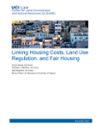
Linking Housing Costs, Land Use Regulation, and Fair Housing
November 2022
This report develops a quality-adjusted measure of housing price increases for five large coastal cities in California: Los Angeles, Oakland, San Diego, San Francisco, and San Jose. It notes that in four of these cities lower-income residents generally experience more rapid housing cost increases than higher income residents, that lower-income residents are more likely to be renters who are harmed by cost increases while homeowners benefit, and that since lower-income residents are more likely to be people of color, the relatively high cost increases that they experience result in racial inequities. The report argues that increasing housing supply in lower-density, higher-income neighborhoods by facilitating the development of diverse housing types could help alleviate rapid increases in housing costs in lower-income neighborhoods. Local planners can use the housing price indices developed for this study to assess whether existing regulation promotes housing development in an equitable manner.
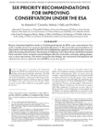
Six Priority Recommendations for Improving Conservation under the ESA
September 2021
This report by CLEANR and the Environmental Policy Innovation Center (EPIC) follows two workshops, hosted in 2019 and 2020, which brought together leading Endangered Species Act (ESA) scholars, advocates, and policymakers in order to first outline a conservation vision for improving the ESA, and then identify and prioritize key recommendations that balance conservation enhancement with political pragmatism. The six priority recommendations offered in the report seek to advance the conservation objectives of the ESA in this century and inform future public dialogue on imperiled species conservation.
Citation: Alejandro E. Camacho, Melissa L. Kelly & Ya-Wei Li, Six Priority Recommendations for Improving Conservation under the ESA, 51 Envtl. L. Rep. 10785 (2021).

Tap into Resilience: Pathways for Localized Water Infrastructure
September 2021
This report focuses on the considerable and largely overlooked opportunities presented by localized water infrastructure (LWI)—distributed systems that extend beyond centralized water infrastructure and are located at or near the point of use. Building on a 2019 dialogue hosted by CLEANR and WaterNow Alliance, the report makes nine recommendations and identifies roughly two dozen achievable, practical action items to overcome the financing, institutional, and legal and policy barriers to largescale adoption of LWI. These recommendations and action items set a foundation for expanding access to and understanding of LWI in an effort to catalyze and accelerate the shift towards sustainable, climate resilient, affordable, and equitable water solutions.
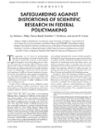
Safeguarding Against Distortions of Scientific Research in Federal Policymaking
January 2021
This comment expands upon the recommendations CLEANR and UCS proposed in their September 2020 factsheet, Conflicts of Interest at Federal Agencies: Recommendations for 2021 and Beyond. It offers conflict-of-interest recommendations for political leaders, agency career staff, and Congress intended to improve disclosure and management policies surrounding political appointments, federal advisory committees, and the scientific peer review process. Its recommendations also aim to enhance oversight and enforcement to protect against such conflicts in the future.
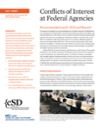
Conflicts of Interest at Federal Agencies
September 2020
This factsheet, produced by CLEANR and the Center for Science and Democracy at the Union of Concerned Scientists (UCS), addresses the ways in which conflicts of interest at federal agencies compromise the role of science in informing environmental policy. Following a 2019 roundtable convened by CLEANR and UCS, the factsheet offers a broad set of recommendations to the President and Administration to protect scientific research from political, ideological, and financial influences, and to preserve its integrity as a policymaking tool.
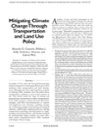
Mitigating Climate Change Through Transportation and Land Use Policy
April 2019
A number of U.S. state and local governments have adopted strategies for reducing greenhouse gas (GHG) emissions from transportation and land development. Although some have made significant progress in reducing GHG emissions from the power sector, transportation emissions in most states continue to rise. This Article, produced following an October 2018 roundtable hosted by CLEANR, details the range of existing and proposed state interventions to reduce transportation-sector GHG emissions, analyzes the trade offs of these strategies, and offers recommendations to improve and supplement such initiatives, including strategic use of planning mandates and funding and technical assistance. Additionally, regulating land use, shifting transportation spending, removing barriers to implementing road pricing policies, and altering standards for environmental impact analysis can more effectively reduce transportation-sector GHG emissions and mitigate climate change.
Citation: Alejandro E. Camacho, Melissa L. Kelly, Nicholas J. Marantz & Gabriel Weil, Mitigating Climate Change Through Transportation and Land Use Policy, 49 Envtl. L. Rep. 10473 (2019).
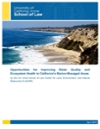
Opportunities for Improving Water Quality and Ecosystem Health in California’s Marine Managed Areas
April 2018
This report is the product of two CLEANR dialogues on Marine Managed Areas (MMAs)—a June 2016 scoping session and a January 2017 plenary roundtable. Based on stakeholder contributions from those dialogues, as well as additional research and interviews, the report explores the current framework for managing coastal water quality and monitoring in MMAs and identifies challenges to and opportunities for enhanced coordination and improved management. Although the report does identify more fundamental legislative changes that might ultimately be needed to protect marine water quality in the long-term, it concentrates on more viable, concrete near-term strategies to: I) enhance MMA water quality through other existing regulatory programs, II) improve water quality monitoring and data access, and III) offset resource constraints on programs protecting marine water quality.
Citation: Elizabeth Taylor, Stephanie Talavera & Alejandro E. Camacho, Improving Water Quality and Ecosystem Health in California’s Marine Managed Areas, 48 Envtl. L. Rep. 10818 (2018).
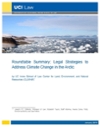
Roundtable Summary: Legal Strategies to Address Climate Change in the Arctic
January 2018
This document is a summary of the themes and topics discussed at an October 2017 CLEANR Roundtable which brought together legal professionals and other experts to discuss their experiences and examine various legal strategies to address climate change and its consequences for communities and wildlife in the U.S. and Canadian Arctic. Particular topics addressed in this summary include: I) identifying and reconciling adaptive management priorities, II) ensuring equity and accountability, III) affirming sovereignty and self-determination, and IV) establishing trust and forming partnerships. The document also identifies several areas recognized by Roundtable participants as deserving of further analysis and/or action.
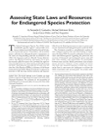
Assessing State Laws and Resources for Endangered Species Protection
October 2017
This report provides a detailed analysis of state endangered species laws and funding to implement the federal Endangered Species Act. The study compares state endangered species protections against the federal law in terms of: existing statutes, the extent of species covered, standards and provisions for listing species, authority for recovering planning, designation of critical habitats, substantive and land-use restrictions, consultation for public action, and habitat modification. The report concludes that without significant state law reforms and massive expansions of funding in most states, devolution of federal authority and responsibility over threatened and endangered species to states is likely to undermine conservation and recovery efforts, lead to a greater number of species becoming imperiled, and result in fewer species recovered.
Citation: Alejandro E. Camacho, Michael Robinson-Dorn, Asena Cansu Yildiz & Tara Teegarden, Assessing State Laws and Resources for Endangered Species Protection, 47 Envtl. L. Rep. 10837 (2017).
See this app from Defenders of Wildlife to evaluate each state’s endangered species protections
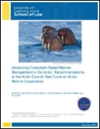
Advancing Ecosystem-Based Marine Management in the Arctic: Recommendations to the Arctic Council Task Force on Arctic Marine Cooperation
September 2016
This report follows from CLEANR’s Arctic II Roundtable, reflecting participants’ recommendations for the Arctic Council Task Force on Arctic Marine Cooperation to advance Ecosystem-Based Management (EBM) in Arctic marine governance. The report emphasizes the importance of EBM—the place-based, comprehensive assessment and management of ecosystem impacts, including those from human activity—in maintaining ecological integrity in large marine ecosystems of the Arctic. The report evaluates its current state of implementation, identifying gaps and opportunities for enhanced cooperation, and proposes means of further analysis, collaboration, and data sharing between organizations within and beyond the region.
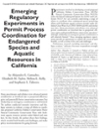
Emerging Regulatory Experiments in Permit Process Coordination for Endangered Species and Aquatic Resources in California
February 2016
CLEANR conducted extensive interviews, research, roundtables, and dialogue sessions to evaluate a range of efforts to coordinate proposed California Habitat Conservation Plans/ Natural Community Conservation Plans with freshwater aquatic resource permits under federal and state laws. The Center shares its findings and makes some suggestions going forward in this Article, published in the February 2016 issue of the Environmental Law Reporter.
Citation: Alejandro E. Camacho, Elizabeth M. Taylor, Melissa L. Kelly & Stephanie L. Talavera, Emerging Regulatory Experiments in Permit Process Coordination for Endangered Species and Aquatic Resources in California, 46 Envtl. L. Rep. 10131 (2016).

Lessons from Area-wide, Multi-agency Habitat Conservation Plans in California
March 2015
This report is the product of extensive research, interviews, and intensive collaborative dialogues co-convened with the Center for Collaboration in Governance as part of CLEANR’s innovative Workshop Roundtable series. As some of the first experiments in inter-governmental conservation planning, area-wide, multi-agency Habitat Conservation Plans (HCPs) exemplify the key challenges of promoting effective and comprehensive conservation governance. The report identifies four topics about which area-wide, multi-agency HCPs provide particularly valuable insights for the many emerging federal and state innovations in conservation.
Citation: Alejandro E. Camacho, Elizabeth M. Taylor & Melissa L. Kelly, Lessons from Area-Wide, Multi-Agency Habitat Conservation Plans in California, 46 Envtl. L. Rep. 10222 (2015).